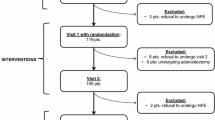Abstract
Allergy is thought to be one of the etiologic factors in otitis media. The purpose of this study was to determine the histopathologic effects of H1 histamine receptor antagonists in an experimental histamine-induced middle ear inflammation model. In group A (20 rabbits), histamine challenge followed a 3-day intramuscular pretreatment with a single dose of 0.1 ml hydroxyzine hydrochloride (50 mg/ml) per day. In group B (20 rabbits), histamine challenge followed a 3-day pretreatment with a single dose 1.2 mg desloratadine per day orally. In group C (20 rabbits), histamine challenge followed a 3-day pretreatment with a single dose 1.2 mg levocetirizine per day orally. On the fourth day after baseline otomicroscopy 0.5 ml histamine 20 mg/ml was injected transtympanically on the right. Middle ear mucosa was removed and the following parameters were assessed: edema, vascular dilatation and congestion, inflammation, acute inflammatory component, presence of eosinophils, activity of the inflammation and fibrosis. A semi-quantitative grading system of 0–3 was used for grading of all parameters and statistical analysis performed by using the Mann–Whitney non-parametric test. Group A mucosae showed lower grades of all the parameters evaluated compared with those of group B. Histopathology of the mucosae of group C showed lower grade of inflammation compared with group B with significant statistical difference for the seven parameters tested. Our data validate the use of antihistamines in the treatment of refractory OME of allergic origin. Oldest H1 antagonists can be replaced by the newest agents who counteract successfully histamine effects, without any interactions or adverse effects from central nervous system.




Similar content being viewed by others
References
Tomonaga K, Kurono Y, Mogi G (1988) The role of nasal allergy in otitis media with effusion, a clinical study. Acta Otolaryngol (Stockh) 458:41–47
Bernstein J, Tsutsumi H, Ogra P (1985) The middle ear mucosal immune system in otitis media with effusion. Am J Otolaryngol 6:162–168
Bluestone C, Klein J (2003) Otitis media and eustachian tube dysfunction. In: Bluestone C, Stool S, Alper C, Arjmand E, Casselbrant M, Dohar J, Yellon R (eds) Pediatric otolaryngology. 4th edn. Saunders, Philadelphia, pp 474–685
Doyle W (1994) Panel on etiology of otitis media with effusion: the role of allergy and tubal function. In: Mogi G (ed) Recent advances in otitis media—proceedings of the second extraordinary international symposium. Kugler Publications, Amsterdam, pp 53–60
Feldman D, Seely J (1988) The necropsy in general. In: Necropsy guide: rodents and the rabbit. CRC Press, Florida, pp 1–21
Schousboe L, Rasmussen L, Ovesen T (2001) Induction of mucin and adhesion molecules in middle ear mucosa. Acta Otolaryngol 121:596–601
MacGlashan D (2003) Histamine: a mediator of inflammation. J Allergy Clin Immunol 112:S53–S59
Fleege J, van Diest P, Baak J (1991) Reliability of quantitative pathological assessments, standards and quality control. In: Baak J (ed) Manual of quantitative pathology in cancer diagnosis and prognosis. Springer, Berlin, pp 151–181
Nunn R, Rose A (1990) Light microscopy. In: Bancroft J, Stevens A (eds) Theory and practice of histological techniques, 3rd edn. Churchill Livingstone, Edinburgh, pp 1–20
Aalto M, Collan Y (1984) Periodic acid-Schiff (PAS) stain in serous tumours and clear cell carcinomas of the ovary. A morphometric study. In: Collan Y (ed) Stereology and morphometry in pathology. Kuopio University Press, Kuopio, pp 193–197
Schousboe L, Rasmussen L, Ovesen T (2001) Induction of mucin and adhesion molecules in middle ear mucosa. Acta Otolaryngol 121:596–601
Mogi G, Tomonaga K, Watanabe T Chaen T (1992) The role of type I allergy in secretory otitis media and mast cells in the middle ear mucosa. Acta Otolaryngol 493(Supl):155–163
Paparella MM, Jung TT, Goycoolea MV (1991) Otitis media with effusion. In: Paparella MM, Shumrick DA, Gluckman JL, Meyerhoff WL (eds) Otolaryngology, vol II. Saunders, Philadelphia, pp 1317–1342
Brown N, Roberts LJ (2001) Histamine, bradykinin, and their antagonists. In: Hardman J, Limbird L (eds) Goodman & Gilman’s. The pharmacological basis of therapeutics. 10th edn. McGraw-Hill, New York, pp 645–668
Dennis R, Whitmire R, Jackson R (1976) Action of inflammatory mediators on middle ear mucosa. A method for measuring permeability and swelling. Arch Otolaryngol 102:420–424
Berger G, Hawke M, Proops, Ranadive N, Wong D (1984) Histamine levels in middle ear effusions. Acta Otolaryngol (Stockl) 98:385–390
Boisvert P, Wasserman S, Schiff M, Ryan A (1985) Histamine-induced middle ear effusion and mucosal histopathology in the guinea pig. Ann Otol Rhinol Laryngol 94:212–216
Molimard M, Diquet B, Strolin Beneddetti M (2004) Comparison of pharmacokinetics and metabolism of desloratadine, fexofenadine, levocetirizine and mizolastine in humans. Fundam Clin Pharmacol 18:399–411
Baroody F, Naclerio R (2000) Antiallergic effects of H1- receptor antagonists. Allergy 55:17–27
Passalacqua G, Canonica G (2005) A review of the evidence from comparative studies of levocetirizine and desloratadine for the symptoms of allergic rhinitis. Clin Ther 27:979–992
Author information
Authors and Affiliations
Corresponding author
Additional information
Presented in part: Oral presentation at the 5th European Congress of Oto-Rhino-Laryngology Head and Neck Surgery. September 11–16, 2004 Rhodes, Greece. Poster at XVIII IFOS World Congress. June 25–30, 2005, Rome, Italy.
Rights and permissions
About this article
Cite this article
Chimona, T.S., Panayiotides, J.G., Papadakis, C.E. et al. Antihistamine effects on experimental middle ear inflammatory model. Eur Arch Otorhinolaryngol 265, 899–905 (2008). https://doi.org/10.1007/s00405-007-0563-y
Received:
Accepted:
Published:
Issue Date:
DOI: https://doi.org/10.1007/s00405-007-0563-y




